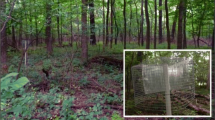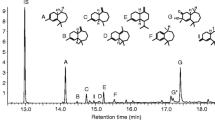Abstract
The phenylpropanoid 4-allylanisole is a compound produced by loblolly pines (Pinus taeda L.), an abundant species in southern pine forests and a preferred host of southern pine beetle (Dendroctonus frontalis Zimmermann). Repellency of individual beetles was demonstrated in laboratory behavioral assays ofD. frontalis and other scolytids. Inhibition was demonstrated in natural populations ofD. frontalis using baited traps. In both tests, response to the inhibitory pheromone verbenone was used for comparison. In the laboratory, a higher proportion of newly emerged and reemergedD. frontalis responded negatively to 4-allylanisole than to verbenone. However, fewer reemergent than newly emerged individuals responded to either compound. In all field trials, the response ofD. frontalis to its attractant pheromone in funnel traps was significantly reduced by simultaneous release of 4-allylanisole. In most trials total reduction did not differ from verbenone; however, unlike verbenone, 4-allylanisole reduced male and female catches proportionally. Both compounds together did not significantly further reduce trap catch. The response of a major predator,Thanasimus dubius (F.), to the attractant pheromone ofD. frontalis, did not differ with the simultaneous release of either verbenone or 4-allylanisole. The results of preliminary field applications are presented and discussed.
Similar content being viewed by others
References
Adams, R.P., andEdmunds, G.F.E. 1989. A re-examination of the volatile oils ofPinus ponderosa Dougl. ex. P. Lawson using ion trap mass spectrometry.Flavour Fragrance J. 4:19–23.
Amman, G.D., Thier, R.W., McGregor, M.D., andSchmitz, R.F. 1989. Efficacy of verbenone in reducing lodgepole pine infestation by mountain pine beetles in Idaho.Can. J. For. Res. 19:60–64.
Analytical Software. 1992. Statistix 4.0 User's Manual. Analytical Software. St. Paul, Minnesota.
Berisford, C.W., Brady, U.E., Fatzinger, C.W., andEbel, B.H. 1986. Evaluation of a repellent for prevention of attacks by three species of southern pine bark beetles (Coleoptera: Scolytidae).J. Entomol. Sci. 21:316–318.
Billings, R.F., andCameron, R.S. 1984. Kairomonal responses of Coleoptera,Monochamus titillator (Cerambycidae),Thanasimus dubius (Cleridae), andTemnochila virescens (Trogostidae), to behavioral chemicals of southern pine bark bettles (Coleoptera: Scolytidae).Environ. Entomol. 13:1542–1548.
Bordasch, R.P., andBerryman, A.A. 1977. Host resistance to the fir engraver beetle,Scolytus ventralis (Coleoptera: Scolytidae) 2. Repellency ofAbies grandis resins and some monoterpenes.Can. Entomol. 109:95–100.
Borden, J.H. 1986. Aggregation pheromones, pp. 74–139,in J.B. Mitton and K.B. Sturgeon (eds.). Bark Beetles in North American Conifers. University of Texas Press, Austin.
Bridges, J.R. 1987. Effects of terpenoid compounds on growth of symbiotic fungi associated with the southern pine beetle.Phytopathology 77:83–85.
Browne, L.E. 1972. An emergence cage and refrigerated collector for wood-boring insects and their associates.J. Econ. Entomol. 65:1499–1501.
Byers, J.A., andWood, D.L. 1980. Interspecific inhibition of the response of the bark beetles,Dendroctonus brevicomis andIps paraconfusus, to their pheromones in the field.J. Chem. Ecol. 6:149–164.
Byers, J.A., andWood, D.L. 1981. Interspecific effects of pheromones on the attraction of the bark beetles,Dendroctonus brevicomis andIps paraconfusus in the laboratory.J. Chem. Ecol. 7:9–18.
Cobb, F.W., Jr., Wood, D.L., Stark, R.W., andParmeter, J.R., Jr. 1968. IV. Theory on the relationships between oxidant injury and bark beetle infestation.Hilgardia 39:141–152.
Cobb, F.W., Jr., Zavarin, E., andBergot, J. 1972. Effect of air pollution on the volatile oil from leaves ofPinus ponderosa.Phytochemistry 11:1815–1818.
Coyne, J.F., andLott, L.H. 1976. Toxicity of substances in pine oleoresin to southern pine beetles.J. Ga. Entomol. Soc. 11:301–305.
Dickens, J.C., Billings, R.F., andPayne, T.L. 1992. Green leaf volatiles interrupt aggregation pheromone response in bark beetles infesting southern pines.Experientia 48:523–524.
Drew, J., andPylant, G.D., Jr. 1966. Turpentine from the pulpwoods of the United States and Canada.Tappi 49:430–438.
Francke, W., andVité, J.P. 1983. Oxygenated terpenes in pheromone systems of bark beetles.z. ang. Entomol. 96:146–156.
Gambliel, H.A., Cates, R.G., Caffey-Moquin, M.K., andPaine, T.D. 1985. Variation in the chemistry of loblolly pine in relation to infection by the blue-stain fungus, pp. 177–184,in S.J. Branham and R.C. Thatcher (eds.). IPM Research Symposium: The Proceedings. USDA Forest Service, SOFES, GTR SO-56.
Hayes, J.L., Ingram, L.L., Jr., Strom, B.L., Rotom, L.M., Boyette, M.W., andWalsh, M.T. 1994. Identification of a host compound and it's practical applications: 4-allylanisole as a bark beetle repellent,in J. Vozzo (ed.). Southern Station Chemical Sciences Meeting Proceedings, Starkville, MS, February 1–2 1994 (in press).
Heikkenen, H.J., andHrutfiord, B.F. 1965.Dendroctonus pseudotsugae: A hypothesis regarding its primary attractant.Science 150:1457–1459.
Himejima, M., Hobson, K.R., Otsuka, T., Wood, D. L., andKubo, I. 1992. Antimicrobial terpenes from oleoresin of ponderosa pine treePinus ponderosa: A defense mechanism against microbial invasion.J. Chem. Ecol. 18:1809–1818.
Hodges, J.D., andPickard, L.S. 1971. Lightning in the ecology of the southern pine beetle,Dendroctonus frontalis (Coleoptera: Scolytidae).Can. Entomol. 103:44–51.
Hunt, D.W.A., Borden, J.H., Lindgren, B.S., andGries, G. 1989. The role of autoxidation ofα-pinene in the production of pheromones ofDendroctonus ponderosae (Coleoptera: Scolytidae).Can. J. For. Res. 19:1275–1282.
Jantz, O.K., andRudinsky, J.A. 1965. Laboratory and field methods for assaying olfactory responses of the Douglas-fir beetle,Dendroctonus pseudotsugae Hopkins.Can. Entomol. 97:935–941.
Kinzer, G.W., Fentiman, A.F., Jr., Page, T.L., Foltz, R.L., Vité, J.P., and Pitman, G.B. 1969. Bark beetle attractants: identification, synthesis and field bioassay of a new compound isolated fromDendroctonus.Nature 221:477–478.
Lampman, R.L., Metcalf, R.L. andAndersen, J.F. 1987. Semiochemical attractants ofDiabrotica undecimpunctata howardi Barber, the southern corn rootworm, andDiabrotica virgifera virgifera Leconte, the western corn rootworm (Coleoptera: Chrysomelidae).J. Chem. Ecol. 13:959–975.
Lindgren, B.S. 1983. A multiple funnel trap for scolytid beetles (Coleoptera).Can. Entomol. 115:299–302.
McCarty, F.A., Billings, P.M., Richerson, J.V., Payne, T.L., andEdson, L.J. 1980. Response of the southern pine beetle to behavioral chemicals in the laboratory.J. Ga. Entomol. Soc. 15:306–317.
Mirov, N.T. 1961. Composition of gum turpentines of pines. PSW, USDA Forest Service, Technical Bulletin No. 1239.
Moeck, H.A., andSimmons, C.S. 1991. Primary attraction of mountain pine beetle,Dendroctonus ponderosae Hopk. (Coleoptera: Scolytidae), to bolts of lodgepole pine.Can. Entomol. 123:299–304.
Moeck, H.A., Wood, D.L., andLindahl, K.Q., Jr. 1981. Host selection behavior of bark beetles (Coleoptera: Scolytidae) attackingPinus ponderosa, with special emphasis on the western pine beetle,Dendroctonus brevicomis.J. Chem. Ecol. 7:49–83.
Nebeker, T.E., Hodges, J.D., andBlanche, C.A. 1993. Host response to bark beetle and pathogen colonization, pp. 157–173,in T.D. Schowalter and G.M. Filip (eds.). Beetle-Pathogen Interactions in Conifer Forests. Academic Press, San Diego, California.
Nijholt, W.W. 1980. Pine oil and oleic acid delay and reduce attacks on logs by ambrosia beetles (Coleoptera: Scolytidae).Can. Entomol. 112:199–204.
O'Donnell, B.P., Payne, T.L., andWalsh, K.D. 1986. Effect of pine oil on landing and attack by the southern pine beetle (Coleoptera: Scolytidae).J. Entomol. Sci. 21:319–321.
Paine, T.D, andHanlon, C.C. 1991. Response ofDendroctonus brevicomis andIps paraconfusus (Coleoptera: Scolytidae) to combinations of synthetic pheromone attractants and inhibitors verbenone and ipsdienol.J. Chem. Ecol. 17:2163–2176.
Payne, T.L. andBillings, R.F. 1989. Evaluation of (S)-verbenone applications for suppressing southern pine beetle (Coleoptera: Scolytidae) infestations.J. Econ. Entomol. 82:1702–1708.
Payne, T.L., Coster, J.E., Richerson, J.V., andHart, E.R. 1978. Field response of the southern pine beetle to behavioral chemicals.Environ. Entomol. 7:578–582.
Payne, T.L., Billings, R.F., Berisford, C.W., Salom, S.M., Grosman, D.M., Dalusky, M.J., andUpton, W.W. 1992. Disruption ofDendroctonus frontalis (Col., Scolytidae) infestations with an inhibitor pheromone.z. ang. Ent., 114:341–347.
Pierce, H.D., Jr., Conn, J.E., Oehlschlager, A.C., andBorden, J.H. 1987. Monoterpene metabolism in female mountain pine beetles,Dendroctonus ponderosa Hopkins, attacking ponderosa pine.J. Chem. Ecol. 13:1455–1480.
Raffa, K.F., Phillips, T.W., andSalom, S.M. 1993. Strategies and mechanisms of host colonization by bark beetles, pp. 103–128,in T.D. Schowalter and G.M. Filip (eds.). Beetle-Pathogen Interactions in Conifer Forests. Academic Press, San Diego, California.
Renwick, J.A.A., andVité, J.P. 1969. Bark beetle attractants: Mechanism of colonization byDendroctonus frontalis.Nature 224:1222–1223.
Renwick, J.A.A., andVité, J.P. 1970. Systems of chemical communication inDendroctonus.Contrib. Boyce Thompson Inst. 24:283–292.
Richerson, J.V., andPayne, T.L. 1979. Effects of bark beetle inhibitors on landing and attack behavior of the southern pine beetle and beetle associates.Environ. Entomol. 8:360–364.
Rudinsky, J.A. 1966a. Scolytid beetles associated with Douglas fir: Response to terpenes.Science 152:218–219.
Rudinsky, J.A. 1966b. Host selection and invasion by the Douglas-fir beetle,Dendroctonus pseudotsugae Hopkins, in coastal Douglas-fir forests.Can. Entomol. 98:98–111.
von Rudloff, E. 1975. Volatile leaf oil analysis in chemosystematic studies of North American conifers.Biochem. Syst. Ecol. 2:131–167.
von Rudloff, E., andLapp, M.S. 1992. Chemosystematic studies in the genusPinus. VII. The leaf oil terpene composition of ponderosa pine,Pinus ponderosa.Can. J. Bot. 70:374–378.
RSalom, S.M., Birgersson, G., Payne, T.L., andBerisford, C.W. 1991. Electroantennogram responses of the southern pine beetle parasitoidDinotiscus dendroctoni (Ashmead) (Hym. Pteromalidae) to potential semiochemicals.J. Chem. Ecol. 17:2527–2538.
Salom, S.M., Ascoli-Christensen, A., Birgersson, G., Payne, T.L., andBerisford, C.W. 1992a. Electroantennogram responses of the southern pine beetle parasitoidCoeloides pissodis (Ashmead) (Hym., Braconidae) to potential semiochemicals.z. ang. Ent. 114:472–479.
Salom, S.M., Billings, R.F., Upton, W.W., Dalusky, M.J., Grosman, D.M., Payne, T.L., Berisford, C.W., andShaver, T.N. 1992b. Effect of verbenone enantiomers and racemicendo-brevicomin on response ofDendroctonus frontalis (Coleoptera: Scolytidae) to attractant-baited traps.Can. J. For. Res. 22:925–931.
Sas Institute. 1988. SAS/STAT User's Guide. SAS Institute, Cary, North Carolina.
Shea, P.J., McGregor, M.D., andDaterman, D.E. 1992. Aerial application of verbenone reduces attack of lodgepole pine by mountain pine beetle.Can. J. For. Res. 22:436–441.
Smith, R.H. 1965. Effect of monoterpene vapors on the western pine beetle.J. Econ. Entomol. 58:509–510.
Smith, R.H. 1977. Monoterpenes of ponderosa pine xylem resin in western United States. U.S. Department of Agriculture Technical Bulletin No. 1532, 48 pp.
Sutherland, M.D., andWells, J.W. 1956. A re-examination of indian and loblolly turpentines.J. Org. Chem. 21:1272–1276.
Thatcher, R.C., andPickard, L.S. 1964. Seasonal variations in activity of the southern pine beetle in East Texas.J. Econ. Entomol. 57:840–842.
Thatcher, R.C., Searcy, J., Coster, J.E., andHertel, G.D. (eds.). 1980. The southern pine beetle. USDA Expanded Southern Pine Beetle Research and Application Program, Forest Service, SEA Technical Bulletin No. 1631.
Tilden, P.E., Bedard, W.D., Wood, D.L. andStubbs, H.A. 1981. Interruption of response ofDendroctonus brevicomis to its attractive pheromone by components of the pheromone.J. Chem. Ecol. 7:183–196.
Tunset, K., Nilssen, A.C., andAndersen, J. 1993. Primary attraction in host recognition of coniferious bark beetles and bark weevils (Col., Scolytidae and Curculionidae).z. ang. Ent. 115:155–169.
Turchin, P., andThoeny, W.T. 1993. Quantifying dispersal of southern pine beetles with mark-recapture experiments and a diffusion model.Ecol. Appl. 3:187–198.
Vité, J.P. andBaader, E. 1990. Present and future use of semiochemicals in pest management of bark beetles.J. Chem. Ecol. 16:3031–3041.
Werner, R.A. 1972a. Aggregation behaviour of the beetleIps grandicollis in response to host-produced attractants.J. Insect. Physiol. 18:423–437.
Werner, R.A. 1972b. Response of the beetle,Ips grandicollis, to combinations of host and insect produced attractants.J. Insect. Physiol. 18:1403–1412.
Wood, D.L. 1982. The role of pheromones, kairomones, and allomones in the host selection and colonization behavior of bark beetles.Annu. Rev. Entomol. 27:411–446.
Zavarin, E., Cobb, F.W., Jr., Bergot, J., andBarber, H.W. 1971. Variation of thePinus ponderosa needle oil with season and needle age.Phytochemistry 10:3107–3114.
Author information
Authors and Affiliations
Additional information
The use of trade or firm names in this publication is for reader information and does not imply endorsement by the U.S. Department of Agriculture of any product or service.
Rights and permissions
About this article
Cite this article
Hayes, J.L., Strom, B.L., Roton, L.M. et al. Repellent properties of the host compound 4-allylanisole to the southern pine beetle. J Chem Ecol 20, 1595–1615 (1994). https://doi.org/10.1007/BF02059883
Received:
Accepted:
Issue Date:
DOI: https://doi.org/10.1007/BF02059883




